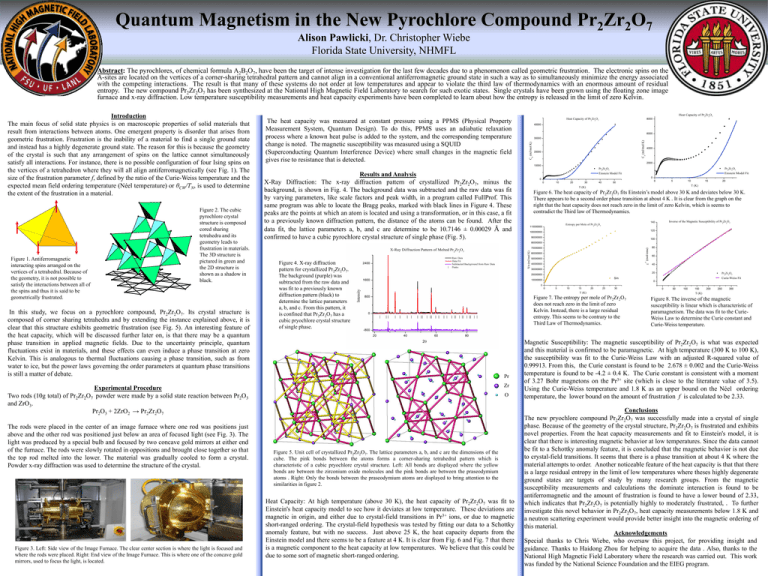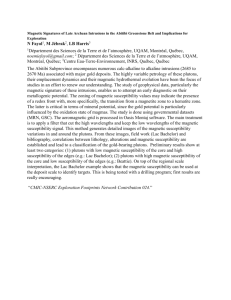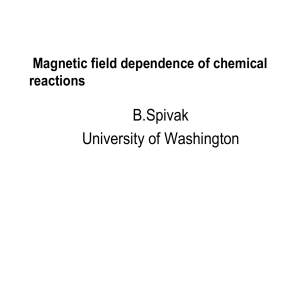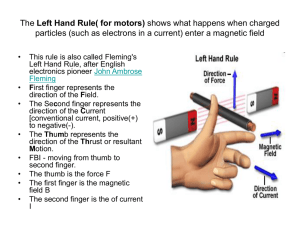Quantum Magnetism in the New Pyrochlore Compound Pr2Zr2O7
advertisement

Quantum Magnetism in the New Pyrochlore Compound Pr2Zr2O7 Alison Pawlicki, Dr. Christopher Wiebe Florida State University, NHMFL Abstract: The pyrochlores, of chemical formula A2B2O7, have been the target of intense investigation for the last few decades due to a phenomenon called geometric frustration. The electronic spins on the A-sites are located on the vertices of a corner-sharing tetrahedral pattern and cannot align in a conventional antiferromagnetic ground state in such a way as to simultaneously minimize the energy associated with the competing interactions. The result is that many of these systems do not order at low temperatures and appear to violate the third law of thermodynamics with an enormous amount of residual entropy. The new compound Pr2Zr2O7 has been synthesized at the National High Magnetic Field Laboratory to search for such exotic states. Single crystals have been grown using the floating zone image furnace and x-ray diffraction. Low temperature susceptibility measurements and heat capacity experiments have been completed to learn about how the entropy is released in the limit of zero Kelvin. Introduction The main focus of solid state physics is on macroscopic properties of solid materials that result from interactions between atoms. One emergent property is disorder that arises from geometric frustration. Frustration is the inability of a material to find a single ground state and instead has a highly degenerate ground state. The reason for this is because the geometry of the crystal is such that any arrangement of spins on the lattice cannot simultaneously satisfy all interactions. For instance, there is no possible configuration of four Ising spins on the vertices of a tetrahedron where they will all align antiferromagnetically (see Fig. 1). The size of the frustration parameter f, defined by the ratio of the Curie-Weiss temperature and the expected mean field ordering temperature (Néel temperature) or θCW/TN, is used to determine the extent of the frustration in a material. Figure 1. Antiferromagnetic interacting spins arranged on the vertices of a tetrahedral. Because of the geometry, it is not possible to satisfy the interactions between all of the spins and thus it is said to be geometrically frustrated. Figure 2. The cubic pyrochlore crystal structure is composed cored sharing tetrahedra and its geometry leads to frustration in materials. The 3D structure is pictured in green and the 2D structure is shown as a shadow in black. In this study, we focus on a pyrochlore compound, Pr2Zr2O7. Its crystal structure is composed of corner sharing tetrahedra and by extending the instance explained above, it is clear that this structure exhibits geometric frustration (see Fig. 5). An interesting feature of the heat capacity, which will be discussed further later on, is that there may be a quantum phase transition in applied magnetic fields. Due to the uncertainty principle, quantum fluctuations exist in materials, and these effects can even induce a phase transition at zero Kelvin. This is analogous to thermal fluctuations causing a phase transition, such as from water to ice, but the power laws governing the order parameters at quantum phase transitions is still a matter of debate. The heat capacity was measured at constant pressure using a PPMS (Physical Property Measurement System, Quantum Design). To do this, PPMS uses an adiabatic relaxation process where a known heat pulse is added to the system, and the corresponding temperature change is noted. The magnetic susceptibility was measured using a SQUID (Superconducting Quantum Interference Device) where small changes in the magnetic field gives rise to resistance that is detected. Results and Analysis X-Ray Diffraction: The x-ray diffraction pattern of crystallized Pr2Zr2O7, minus the background, is shown in Fig. 4. The background data was subtracted and the raw data was fit by varying parameters, like scale factors and peak width, in a program called FullProf. This same program was able to locate the Bragg peaks, marked with black lines in Figure 4. These peaks are the points at which an atom is located and using a transformation, or in this case, a fit to a previously known diffraction pattern, the distance of the atoms can be found. After the data fit, the lattice parameters a, b, and c are determine to be 10.7146 ± 0.00029 Å and confirmed to have a cubic pyrochlore crystal structure of single phase (Fig. 5). Figure 4. X-ray diffraction pattern for crystallized Pr2Zr2O7. The background (purple) was subtracted from the raw data and was fit to a previously known diffraction pattern (black) to determine the lattice parameters a, b, and c. From this pattern, it is confined that Pr2Zr2O7 has a cubic pryochlore crystal structure of single phase. The rods were placed in the center of an image furnace where one rod was positions just above and the other rod was positioned just below an area of focused light (see Fig. 3). The light was produced by a special bulb and focused by two concave gold mirrors at either end of the furnace. The rods were slowly rotated in oppositions and brought close together so that the top rod melted into the lower. The material was gradually cooled to form a crystal. Powder x-ray diffraction was used to determine the structure of the crystal. Figure 3. Left: Side view of the Image Furnace. The clear center section is where the light is focused and where the rods were placed. Right: End view of the Image Furnace. This is where one of the concave gold mirrors, used to focus the light, is located. Figure 7. The entropy per mole of Pr2Zr2O7 does not reach zero in the limit of zero Kelvin. Instead, there is a large residual entropy. This seems to be contrary to the Third Law of Thermodynamics. Pr Zr Experimental Procedure Two rods (10g total) of Pr2Zr2O7 powder were made by a solid state reaction between Pr2O3 and ZrO3. Pr2O3 + 2ZrO2 → Pr2Zr2O7 Figure 6. The heat capacity of Pr2Zr2O7 fits Einstein’s model above 30 K and deviates below 30 K. There appears to be a second order phase transition at about 4 K . It is clear from the graph on the right that the heat capacity does not reach zero in the limit of zero Kelvin, which is seems to contradict the Third law of Thermodynamics. O Figure 5. Unit cell of crystallized Pr2Zr2O7. The lattice parameters a, b, and c are the dimensions of the cube. The pink bonds between the atoms forms a corner-sharing tetrahedral pattern which is characteristic of a cubic pryochlore crystal structure. Left: All bonds are displayed where the yellow bonds are between the zirconium oxide molecules and the pink bonds are between the praseodymium atoms . Right: Only the bonds between the praseodymium atoms are displayed to bring attention to the similarities in figure 2. Heat Capacity: At high temperature (above 30 K), the heat capacity of Pr2Zr2O7 was fit to Einstein's heat capacity model to see how it deviates at low temperature. These deviations are magnetic in origin, and either due to crystal-field transitions in Pr3+ ions, or due to magnetic short-ranged ordering. The crystal-field hypothesis was tested by fitting our data to a Schottky anomaly feature, but with no success. Just above 25 K, the heat capacity departs from the Einstein model and there seems to be a feature at 4 K. It is clear from Fig. 6 and Fig. 7 that there is a magnetic component to the heat capacity at low temperatures. We believe that this could be due to some sort of magnetic short-ranged ordering. Figure 8. The inverse of the magnetic susceptibility is linear which is characteristic of paramagnetism. The data was fit to the CurieWeiss Law to determine the Curie constant and Curie-Weiss temperature. Magnetic Susceptibility: The magnetic susceptibility of Pr2Zr2O7 is what was expected and this material is confirmed to be paramagnetic. At high temperature (300 K to 100 K), the susceptibility was fit to the Curie-Weiss Law with an adjusted R-squared value of 0.99913. From this, the Curie constant is found to be 2.678 ± 0.002 and the Curie-Weiss temperature is found to be -4.2 ± 0.4 K. The Curie constant is consistent with a moment of 3.27 Bohr magnetons on the Pr3+ site (which is close to the literature value of 3.5). Using the Curie-Weiss temperature and 1.8 K as an upper bound on the Néel ordering temperature, the lower bound on the amount of frustration f is calculated to be 2.33. Conclusions The new pryochlore compound Pr2Zr2O7 was successfully made into a crystal of single phase. Because of the geometry of the crystal structure, Pr2Zr2O7 is frustrated and exhibits novel properties. From the heat capacity measurements and fit to Einstein's model, it is clear that there is interesting magnetic behavior at low temperatures. Since the data cannot be fit to a Schottky anomaly feature, it is concluded that the magnetic behavior is not due to crystal-field transitions. It seems that there is a phase transition at about 4 K where the material attempts to order. Another noticeable feature of the heat capacity is that that there is a large residual entropy in the limit of low temperatures where theses highly degenerate ground states are targets of study by many research groups. From the magnetic susceptibility measurements and calculations the dominate interaction is found to be antiferromagnetic and the amount of frustration is found to have a lower bound of 2.33, which indicates that Pr2Zr2O7 is potentially highly to moderately frustrated, . To further investigate this novel behavior in Pr2Zr2O7, heat capacity measurements below 1.8 K and a neutron scattering experiment would provide better insight into the magnetic ordering of this material. Acknowledgements Special thanks to Chris Wiebe, who oversaw this project, for providing insight and guidance. Thanks to Haidong Zhou for helping to acquire the data . Also, thanks to the National High Magnetic Field Laboratory where the research was carried out. This work was funded by the National Science Foundation and the EIEG program.










